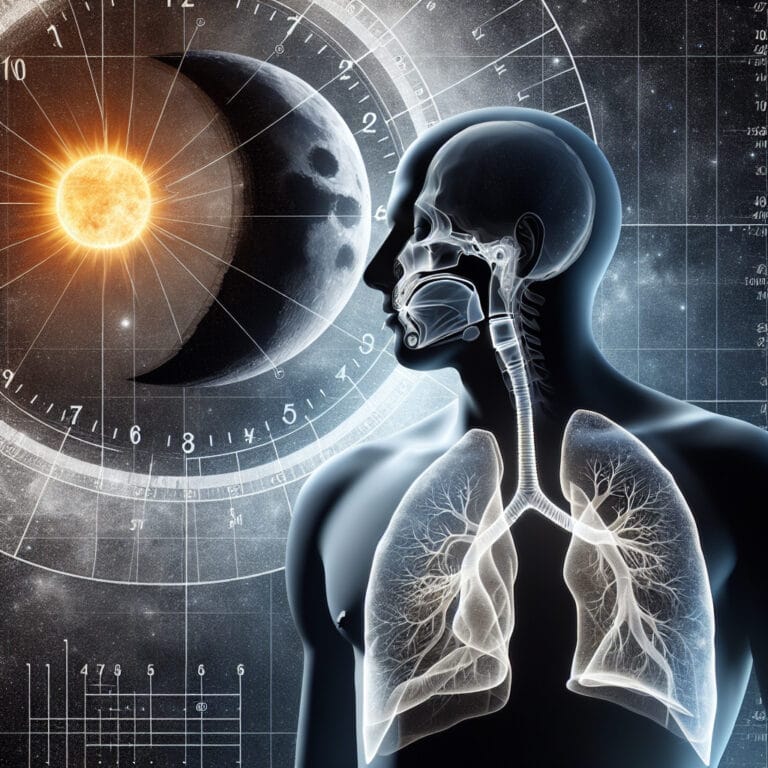
Adapting to Shift Work: Strategies for Maintaining Healthy Breathing Patterns
Table of Contents
- Introduction to Shift Work and Its Challenges
- Understanding Circadian Rhythms and Breathing
- Strategies for Adapting Breathing Patterns to Shift Work
- The Role of the Work Environment in Respiratory Health
- Leveraging Technology and Tools
- Professional Healthcare Support
- Conclusion
- Frequently Asked Questions
Introduction to Shift Work and Its Challenges
Shift work, a staple in industries that require round-the-clock operations, disrupts the circadian rhythm—the internal clock regulating the sleep-wake cycle and numerous physiological processes. A systematic review of shift workers—especially those on night shifts—reveals a startling increased risk of developing respiratory issues. Unlike their day shift counterparts, night shift workers face circadian misalignment, which can exacerbate health problems such as obstructive sleep apnea and other sleep disorders. The intricacies of our biological systems mean that our heart rate, blood pressure, temperature, digestion, and even brain activity fluctuate in sync with our circadian rhythms; disruptions caused by irregular work schedules can lead to digestive upsets or obesity—a known risk factor for respiratory conditions.
It’s not just about getting enough rest; the quality of sleep is paramount for those who fall asleep when their bodies expect wakefulness. Consecutive night shifts compound this problem by preventing adaptation to night work, placing workers at a higher risk for conditions like metabolic syndrome and cardiovascular disease—all linked to poor respiratory health. Occupational health specialists stress the importance of synchronized circadian phases for overall well-being; yet consecutive days of night shifts create cumulative deficits in sleep and recovery.
Furthermore, research indicates that nighttime exposure to environmental factors often found during shift schedules—such as cooler air temperatures or variable levels of industrial pollutants—can aggravate asthma or other chronic lung diseases. Shift system disruption also correlates with an increased incidence of gastrointestinal disorders which can indirectly influence respiratory function through complex inter-system relationships within the body.
For individuals whose livelihood depends on non-traditional hours—like healthcare professionals working in sleep medicine or factory employees engaged in 24/7 production—the key to maintaining optimal pulmonary health lies in strategic approaches towards managing their unique challenges: embracing adaptable sleeping environments conducive to rest during daylight hours and employing relaxation techniques before bedtime are critical steps towards mitigating detrimental effects. In essence, understanding the intersection between occupational demands and physiological needs is crucial for protecting the respiratory well-being of shift workers embedded within an ever-demanding economy.
Understanding Circadian Rhythms and Breathing
The silent toll of shift work on respiratory health is a narrative deeply interwoven with our circadian rhythms, those natural physiological cycles dictating when we should rest and be active. At the core of this complex interplay lies the profound impact that working off-hours has on our body’s ability to regulate breathing and maintain adequate oxygen levels, especially for night shift workers. Occupying positions against the grain of typical day shifts, these individuals find themselves facing a heightened risk of circadian disruption—a silent force that subtly yet substantially affects their pulmonary system.
As night falls and most are winding down, night workers’ bodies must defy their internal clocks to remain alert and functioning. This circadian misalignment does not come without cost; research suggests it can lead to altered oxygen consumption patterns, where the lungs’ capacity to exchange gases becomes less efficient during periods typically reserved for sleep. Consequently, there’s an increased risk ratio based on systematic reviews showing that those who work nights consistently report higher incidence rates of obstructive sleep apnea—a condition marked by intermittent airflow blockage during sleep—compared to general population benchmarks.
Moreover, since heart rate blood pressure temperature digestion and brain activity fluctuate in tandem with our circadian clock, disruptions caused by inconsistent sleep-wake cycles can exacerbate health disorders beyond just tiredness or excessive sleepiness. Metabolic syndrome and cardiovascular disease—both intricately linked to respiratory wellness—are also more prevalent among those who have grappled with frequent consecutive night shifts or prolonged exposure to atypical work schedules.
Acknowledging the intrinsic link between proper lung function and well-regulated circadian rhythms is crucial for occupational health professionals as they develop strategies tailored towards minimizing risks associated with shift systems. For instance, implementing measures such as planned naps or light therapy could aid shift workers in better aligning their biological clocks with their professional demands. Even more significant is recognizing how social isolation often experienced during these hours can compound stress levels that may indirectly affect breathing patterns. Addressing these factors holistically presents a clearer path toward safeguarding the respiratory health of millions who keep our world running regardless of whether it works nights or daybreak beckons anew.
| Aspect | Details |
|---|---|
| Circadian Rhythms | Natural physiological cycles that dictate when we should rest and be active. |
| Impact of Shift Work | Working off-hours can disrupt the body’s natural rhythm, affecting the ability to regulate breathing and maintain oxygen levels. |
| Risks for Night Workers | Increased risk of circadian disruption and associated pulmonary system effects, including higher incidence rates of obstructive sleep apnea. |
| Oxygen Consumption Patterns | Altered during times typically reserved for sleep, leading to less efficient gas exchange in the lungs. |
| Additional Health Disorders | Disruptions can exacerbate metabolic syndrome, cardiovascular disease, and other health problems. |
| Preventive Measures | Strategies like planned naps or light therapy could help realign biological clocks with work demands. |
| Social Isolation | Can compound stress levels and indirectly affect breathing patterns. |
| Occupational Health Strategies | Developing tailored strategies to minimize risks associated with shift work, focusing on lung function and circadian rhythm regulation. |
Strategies for Adapting Breathing Patterns to Shift Work
Navigating the labyrinth of shift work requires a resilience that goes beyond mere stamina—it demands a strategic approach to preserve the delicate balance of one’s circadian rhythm, especially for those undertaking night shifts. The systematic review of literature spotlights an increased risk for various health problems in shift workers, with respiratory issues sitting prominently in this collection of occupational hazards. As these workers contend with erratic schedules that see them active when the rest of the world sleeps, their internal clocks often become victims to significant circadian disruption—an imbalance that can lead directly to conditions such as obstructive sleep apnea and heighten susceptibility to diseases including type diabetes, heart disease, and metabolic syndrome.
Addressing these challenges begins with establishing a consistent sleep schedule, essential for mitigating sleep deprivation’s grip on both mental alertness and pulmonary function. Night workers are encouraged to create an environment conducive to “daytime” slumber post their nocturnal labor; blackout curtains coupled with noise-canceling elements lay the groundwork for restorative sleep despite sunlight beckoning from outside. Incorporation of relaxation techniques before hitting the pillow—like deep breathing exercises—can accelerate the descent into deep sleep phases crucial for physical recovery.
Furthermore, tailored breathing exercises serve as a dual-purpose ally for shift workers—a tool not only promoting tranquil transitions into sleep but also acting as a stress-obliterator during wakeful hours amidst night work’s social isolation. Techniques such as diaphragmatic breathing are known to reduce anxiety levels which may otherwise impair both cardiovascular and respiratory systems via psychosomatic pathways.
Nutrition and hydration too play pivotal roles in maintaining peak respiratory health amongst those in shift systems. High antioxidant foods counteract potential inflammation within airways while adequate hydration keeps mucous membranes moist—an innate defense against airborne irritants encountered during nightly duties or morning shifts’ sleepy commute home. Additionally, avoidance of heavy meals prior to sleeping aids in preventing digestive upsets obesity—a documented risk factor contributing indirectly yet significantly towards compromised lung function.
It is imperative then that occupational health provisions incorporate not just education around these practices but also offer supports like counseling services addressing psychological strains inherent within non-standard work schedules—be it excessive sleepiness or accidents due resulting from fatigue-driven errors—not forgetting assessments leading towards interventions like continuous positive airway pressure (CPAP) therapy where medically indicated. Those tasked with guarding our societal norms through night shift work must be afforded every opportunity by employers and healthcare professionals alike so they can maintain not just productivity but holistic well-being inclusive of robust respiratory health regardless if they fall asleep when stars dot the sky or rise when daybreak ushers anew challenges ahead.
The Role of the Work Environment in Respiratory Health
The insidious impact of shift work on respiratory health cannot be overstated, as the delicate interplay between our circadian rhythms and occupational demands gives rise to a slew of health challenges for those who toil through the night. In a workplace where air quality can oscillate with varying degrees of industrial pollutants, shift workers’ lungs are incessantly assaulted by an invisible enemy. It is not merely enough to acknowledge this hazard; proactive measures must be enforced to enhance air purity, such as installing high-efficiency particulate air (HEPA) filters and ensuring proper ventilation systems are in place—mitigating the inhalation of harmful substances that can exacerbate asthma or lead to chronic bronchitis.
Intriguingly, ergonomics plays a vital role in bolstering lung function amongst night workers. An ergonomic assessment tailored for those engaged in night shifts could reveal opportunities for improving posture during work tasks—an upright stance encourages deeper breathing and optimal oxygen exchange. This synergy between ergonomic design and respiration ensures that each breath taken during long hours is not only clean but also serves its physiological purpose effectively.
Moreover, time management emerges as an unsung hero in the quest for respiratory well-being among shift workers. Intentional scheduling of breaks within nocturnal routines allows lungs to recuperate from sustained activity periods—similarly important as structured sleep times post-shifts. These rest intervals offer chances for deep-breathing exercises or simply moments away from potential airborne contaminants—a crucial step towards maintaining a robust pulmonary system.
As systematic reviews continue painting a convincing picture—the correlation between irregular work schedules and increased risk ratios concerning obstructive sleep apnea, cardiovascular disease, and metabolic syndrome grows clearer—it becomes apparent that protecting the respiratory health of night workers isn’t just about addressing immediate symptoms like excessive sleepiness or countering accidents due to fatigue. Instead, it’s an intricate mosaic requiring comprehensive approaches: optimizing indoor air quality; implementing ergonomically sound practices; managing time effectively for adequate breaks—all woven together with awareness around circadian alignment—to foster an environment where night shift employees don’t just survive but thrive in their roles without compromising their precious breaths under the cloak of darkness.
Leveraging Technology and Tools
Shift workers, especially those navigating the nocturnal demands of night shifts, encounter a unique set of respiratory challenges, often invisible to their day shift counterparts. The systematic review of occupational health data highlights an increased risk for conditions like obstructive sleep apnea among these individuals due to circadian misalignment—a consequence of irregular work schedules that disrupts the natural rhythm of heart rate, blood pressure, temperature digestion and brain activity fluctuations. This circadian disruption not only hampers one’s ability to fall asleep during unconventional hours but also elevates their susceptibility to a spectrum of health problems including metabolic syndrome and cardiovascular disease.
In response to this silent epidemic amongst night shift workers, technology has become an ally in monitoring and managing respiratory health. Wearable devices have emerged as vigilant guardians tracking breathing patterns and oxygen levels throughout work nights—providing valuable feedback that can prevent sleep disorders or alert workers to potential risks before they escalate into more severe health disorders. Meanwhile, apps designed for guided breathing exercises offer reprieve from the stress associated with night shift work; they serve as convenient tools for mitigating social isolation and promoting relaxation amidst challenging schedules.
Furthermore, online resources have proliferated offering support systems tailored specifically to those whose professional lives defy conventional day work timetables. These platforms provide comprehensive information regarding sleep medicine advancements pertinent to shift system-induced disruptions while facilitating connections with peer support groups where experiences are shared—and solutions forged—in solidarity against common adversities faced by night workers.
Tackling the increased risk ratios linked with consecutive days on the night shift requires an integrated approach; it’s about leveraging innovative solutions alongside traditional healthcare wisdom. From ensuring proper restorative sleep through wearable tech data insights to accessing communal strength via digital networks—the journey towards safeguarding respiratory well-being in shift workers is multifaceted but navigable with informed strategies that align workplace demands with biological needs.
| Aspect | Description | Examples |
|---|---|---|
| Challenges | Unique respiratory challenges due to circadian misalignment, leading to health risks like obstructive sleep apnea, metabolic syndrome, and cardiovascular disease. | N/A |
| Wearable Devices | Track breathing patterns and oxygen levels, provide feedback to prevent sleep disorders and alert to potential health risks. | Fitness trackers, Smartwatches |
| Breathing Exercise Apps | Assist with stress management and promote relaxation through guided breathing exercises. | Headspace, Calm |
| Online Resources | Support systems with information on sleep medicine and peer support groups for night shift workers. | Sleep Foundation, Shift Work Disorder websites |
| Integrated Approach | Combines technology with traditional healthcare to ensure restorative sleep and access to community support. | Use of both wearable tech and participation in online support communities |
Professional Healthcare Support
As the clock ticks past midnight, shift workers continue their toil under the cloak of darkness, often unaware of the silent battle their bodies wage against disrupted circadian rhythms. These night warriors face a systematic increased risk for a gamut of respiratory issues underscored by irregular work schedules that disturb natural physiological cycles. While day workers bask in harmony with their circadian phase, night shift workers confront heightened vulnerability to obstructive sleep apnea and other health disorders due to the misalignment between their internal clocks and nocturnal lifestyles. The elusive quest for quality rest is further complicated by social isolation and varying environmental conditions encountered during night work.
Occupational health services play an indispensable role in illuminating this shadowed pathway—guiding those who fall asleep when stars are out towards medical advice as early signs of respiratory distress emerge. Vigilance in recognizing symptoms such as excessive sleepiness or persistent coughs should prompt visits to healthcare professionals skilled in sleep medicine. Shift schedules may inadvertently elevate one’s risk factor for chronic conditions like heart disease or type diabetes; hence it’s crucial that occupational health experts monitor consecutive days worked at night, assessing both cumulative fatigue and any notable deviation from regular breathing patterns.
Accessing respiratory therapy and interventions tailored specifically for shift system challenges can be transformative for those employed in industries where working nights is par for the course. From non-invasive ventilation support to cognitive-behavioral strategies designed to re-align disrupted sleep cycles—it’s within these specialized treatments that relief can often be found by night shift workers battling against circadian disruption.
This intricate tapestry woven by alternating shifts demands more than just awareness—it necessitates proactive engagement with healthcare networks adept at navigating the unique landscape of shift work-related health problems. Forging partnerships between employees, employers, and occupational health services is pivotal not only in providing immediate care but also ensuring long-term well-being through preventive measures catered to those whose waking hours transcend conventional morning shifts. As our economy thrives on round-the-clock productivity, safeguarding the pulmonary fortitude of our workforce must become an embedded priority within organizational culture—an ethos where every breath counts whether taken amidst daylight bustle or against the tranquil backdrop of a sleeping world.
Conclusion
The relentless ticking of the clock during night shifts can take a toll on shift workers’ health, with studies indicating an increased risk for respiratory problems—a stark reminder that our bodies are intricately tied to circadian rhythms. Shift work, particularly when it stretches through the night, disrupts these rhythms and has been systematically reviewed to reveal a higher risk of conditions like obstructive sleep apnea, heart disease, and metabolic syndrome. For those who fall asleep as dawn approaches or who wake prior to sunset for their nocturnal duties, maintaining synchronicity between their circadian clock and professional obligations becomes a challenge fraught with potential health disorders.
Occupational health professionals recognize that consecutive night shifts exacerbate circadian misalignment by creating cumulative deficits in sleep recovery; this is not merely about combating excessive sleepiness but also addressing the broader spectrum of risks including cardiovascular disease and digestive upsets obesity. It is essential for both employers and employees to understand that adapting work schedules to support better alignment with natural biological cycles could mitigate many issues associated with shift work. Regularly rotating day shifts with night work can minimize social isolation and promote more consistent sleeping patterns.
Advocacy for the well-being of night workers is paramount; incorporating planned rest breaks during shifts, facilitating environments conducive to quality daytime sleep, and employing relaxation strategies before bedtime could all contribute positively towards balancing disrupted physiological processes such as heart rate blood pressure temperature digestion. Investing in education around sleep medicine advances related not just to general population benchmarks but tailored specifically towards shift system challenges would be beneficial. This holistic approach goes beyond mere survival during night shift work—it’s about thriving despite the demanding economy that often necessitates round-the-clock productivity.
For those ensnared in a schedule dictated by consecutive days of nocturnal labor—be it factory workers or healthcare professionals working nights—implementing these nuanced strategies might mean more than just staying awake at their posts; it might mean safeguarding one crucial aspect of their health: breathing easy even when the rest of the world sleeps.



